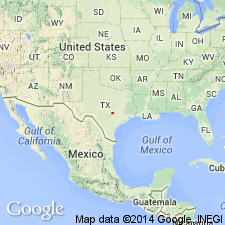
- Usage in publication:
-
- Hammett shale
- Modifications:
-
- Original reference
- Dominant lithology:
-
- Shale
- Limestone
- AAPG geologic province:
-
- Ouachita folded belt
Summary:
Pg. 69; J.R. Sandige, chairman, 1956, Gulf Coast Assoc. Geol. Soc. Field Trip Gdbk., p. 12-13, fig. 5. Hammett shale. Name applied to unit between Sycamore sands below and Cow Creek limestone above. Present in southeastern Texas, subsurface and surface. Where exposed, lower 20 feet consists of buff-colored shales, dark when fresh, with thin fossiliferous limestone at base. Remaining 40 to 45 feet, as revealed in cored section, is largely shale with fine sand streaks in base and middle, latter associated with a bed of small clams; uppermost part contains fossiliferous dolomitic limestones. Cow Creek boundary is transitional, arbitrarily determined at base of lowermost well-developed limestone; lower contact is surface of disconformity marked sporadically by pebble and boulder layer immediately above top of Sycamore. Age is Early Cretaceous.
Type section (subsurface): completely cored section at Hamilton Pool coreholes 1 and 2. Named from Hammett Crossing, about 1 mi west of Hamilton Pool in western Travis Co., southeastern TX.
Source: US geologic names lexicon (USGS Bull. 1200, p. 1656).
For more information, please contact Nancy Stamm, Geologic Names Committee Secretary.
Asterisk (*) indicates published by U.S. Geological Survey authors.
"No current usage" (†) implies that a name has been abandoned or has fallen into disuse. Former usage and, if known, replacement name given in parentheses ( ).
Slash (/) indicates name conflicts with nomenclatural guidelines (CSN, 1933; ACSN, 1961, 1970; NACSN, 1983, 2005, 2021). May be explained within brackets ([ ]).

